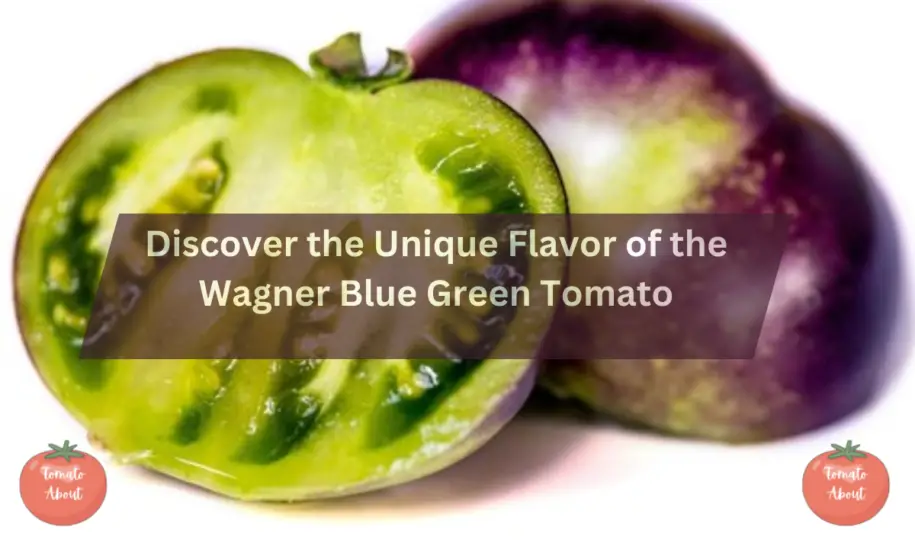Have you ever seen a blue tomato? Or a green one? While red is the most common color we associate with tomatoes, there are actually cultivars that produce stunningly colorful blue, purple, pink, yellow, striped, and even black tomatoes. One of the most unique is the Wagner Blue Green Tomato. With its cool tones of blue, green, and purple, this heirloom beauty will add serious visual appeal to sandwiches, salads, and more.
With its striking blue-green color, petite size, and complex flavor, the Wagner Blue Green is truly a tomato lover’s dream. Keep reading to learn all about this one-of-a-kind tomato variety.
A Brief History of the Wagner Blue Green Tomato
The Wagner Blue Green Tomato was first developed in the 1990s by legendary tomato breeder Tom Wagner of Tater Mater Seeds. Wagner made a name for himself by expertly crossing heirloom varieties to create entirely new cultivars.
Two of his most famous creations were the Green Zebra and Schimmeig Cuozzo tomatoes. To make the Wagner Blue Green, he crossed his famous Green Zebra with another blue tomato called Indigo Apple. The result was a totally unique heirloom variety.
What Makes the Wagner Blue Green Tomato Special?
So what sets the Wagner Blue Green Tomato apart from other tomatoes? For starters, its color is truly eye-catching. The skin ripens to a rich indigo blue or deep purple, especially when exposed to sunlight. Meanwhile, the shaded underside takes on a lively greenish-gold hue.
Despite its small size (about 4 ounces), this tomato has an outstanding flavor. Expect a perfect balance of rich, tangy sweetness with a hint of citrus. The flesh remains a verdant green when sliced open.
Of course, the Wagner Blue Green Tomato offers more than just novelty color. As an heirloom, its seeds produce “true to type” offspring with the same traits as the parent. So home gardeners can save seeds year after year.
Quick Facts
- Color: Blue-purple skin with green-gold undersides. Green flesh inside
- Size: 3-4 ounces on average.
- Shape: Oval, similar to cherry tomatoes.
- Texture: Juicy, meaty with a firm bite.
- Flavor: Sweet and tangy, with citrusy acidic notes.
- Plant Type: Indeterminate vines.
- Maturity: Starts ripening around 70-80 days after transplanting.
- Yield: 5-10 pounds per plant.
- Hardiness: Grows in zones from cool coastal to hot humid climates.
What you like
- The unique blue-green color is eye-catching and fun to grow
- The small size makes them perfect for snacking and salads
- The complex sweet yet tart flavor is excellent for fresh eating
- As an heirloom, seeds can be saved for future harvests
- Indeterminate vines produce tomatoes all season long
- Does well in a wide range of climates and zones
What you don’t like
- Seeds can be difficult to find since it’s not a common mainstream variety
- Requires staking or caging due to tall, sprawling vines
- Susceptible to cracking if irrigation is not consistent
- Blue-green color means direct sunlight can cause uneven ripening
- Soft flesh may not be ideal for shipping or long storage
- Low yields compared to many hybrid tomato varieties
- Can harbor pests like hornworms if not frequently monitored
- Must start seeds indoors and time transplanting properly
How to Grow Wagner Blue Green Tomatoes
Without a doubt, the extraordinarily colorful Wagner Blue Green tomato offers a delightful burst of flavor but it does require some special tending in the garden for optimal results.
When starting Wagner Blue Green tomatoes from seed indoors, use a sterile seed starting mix and provide gentle bottom warmth of 75-80°F for germinating the seeds. The mild heat helps overcome the seeds’ stubbornness to sprout. The Jiffy Greenhouse is a suitable setup for starting the seeds 6-8 weeks prior to transplanting.
Once nighttime temps are dependably over 50°F, the Wagner Blue Green transplants can be moved to the garden. Give plants at least 2-3 feet spacing in full sunlight (minimum 6 hours). To support the vigorous climbing vines, put 5-6 foot tall tomato cages like the Oval Cage by VegTrug in place when transplanting.
Wagner Blue Green tomatoes need steady moisture, so add mulch and use drip irrigation. The Irrigation Kit by Orbit affords adjustable drip watering right to each plant’s roots. Refrain from overhead watering.
As the plants develop, prune back leaves and shoots to open up the plant for adequate airflow and sunlight exposure. Check for pests like stink bugs and treat organically with neem oil spray if detected. Harvest ripe fruits when deep indigo and slightly soft.
With attentive care, each Wagner Blue Green plant can yield up to 10 pounds over the season!
Harvesting and Storing Your Crop
The ripe fruit of Wagner Blue Green tomatoes is fragile, so handle them gently to avoid bruising. Use the following tips for the best quality harvest:
- Allow tomatoes to fully ripen on the vine before picking. They should feel slightly soft.
- Check plants daily and harvest ripe fruit promptly to prevent splitting or rotting on the vine.
- Use pruners or scissors for clean cuts rather than pulling or twisting the fruits off.
- Avoid placing ripe tomatoes in direct sunlight, as this can cause uneven ripening.
- Store freshly picked tomatoes at room temperature out of direct sunlight. Refrigeration ruins texture and flavor.
- Canned or frozen blue-green tomatoes work well in recipes like fried green tomatoes.
Health Benefits of the Wagner Blue Green Tomato
All tomatoes are packed with beneficial nutrients, and the Wagner Blue Green is no exception. Tomatoes are an excellent source of antioxidants like lycopene, beta-carotene, and vitamin C.
They also provide Vitamin K, potassium, folate, and fiber. The rich green flesh of the Wagner Blue Green contains high levels of chlorophyll, which has anti-inflammatory and detoxifying properties.
Some studies suggest that green tomatoes have higher antioxidant levels than fully ripe red tomatoes. So harvesting your Wagner Blue Green Tomatoes both unripe and ripe gives you the best of both worlds!
How to Save Seeds from Wagner Blue Green Tomato Plants
One of the great benefits of growing heirloom tomatoes like the Wagner Blue Green is that you can save seeds from season to season. Here’s how:
- Select only the healthiest, best-shaped tomatoes from your healthiest plants.
- Scoop out the gel and seeds into a jar. Add a little water.
- Allow to ferment for 2-3 days. Viable seeds will sink to the bottom.
- Pour off the top layer. Rinse the seed mixture through a fine sieve.
- Spread seeds on a plate or paper towel. Allow to thoroughly dry for about a week.
- Store dried seeds in an airtight container in a cool, dark place. Seeds remain viable for 4+ years.
How to Use Wagner Blue Green Tomatoes
The small size and unique green-blue color of the Wagner Blue Green Tomato make it perfect for highlighting in fresh recipes where they can really stand out.
- Make a stunning Caprese salad with alternating slices of green, blue, and red tomatoes.
- Toss halved blue-green tomatoes into mixed green or grain salads. The colors pop against the greens!
- For breakfast, enjoy sliced blue tomatoes on toast with olive oil, salt, pepper, and fresh basil.
- Use them to make blue tomato salsa or add to gazpacho for a cool color contrast.
- Make fried green tomatoes using unripe fruits.
- Oven roast or slow roast halves with olive oil and herbs.
- Puree into a colorful tomato sauce. Use to top pasta, pizzas, and more.
- Use diced blue tomatoes in place of regular tomatoes in any recipe.
The slightly acidic flavor pairs well with mozzarella, parmesan, basil, greens, zucchini, eggplant, onions and garlic. The small size can be inconvenient for sandwiches, but they work great for bruschetta.
Where to Buy Wagner Blue Green Tomato Seeds or Plants
You can purchase Wagner Blue Green seeds from reputable companies like Baker Creek Heirloom Seeds, Tomato Growers Supply Company, or Victory Seeds. Plants occasionally appear at local nurseries that carry heirloom varieties.
You may also be able to find fresh Wagner Blue Green Tomatoes at farmers’ markets, farm stands, and specialty grocers during peak tomato season. But they are still relatively hard to find, making them an extra special treat!
Wrapping up!
Part of the fun of heirloom tomatoes is discovering the incredible diversity of colors, shapes, flavors, and textures they offer. If you want to add something truly unique to your garden, be sure to give the Wagner Blue Green Tomato a try.
The striking indigo and green fruits are sure to inspire curiosity and delight! With proper care, you’ll be rewarded with a bountiful harvest of these visually stunning slicers all summer long.


